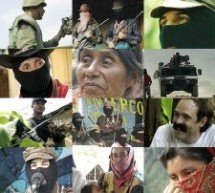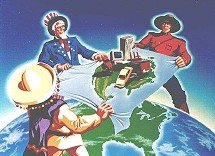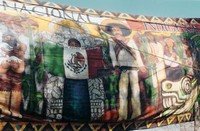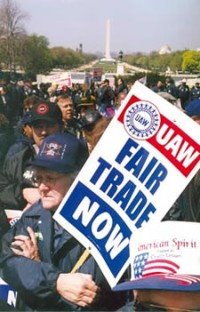The Myth of Free Trade
 The Myth of Free Trade Videos The Myth of Free Trade Videos*The Myth of Free Trade *Growing Reaction to Globalisation *the Last Zapatistas *Zapatista *Zapatista Uprising & Nafta Years Later  *Growing Global Gap Between Rich and Poor *Growing Global Gap Between Rich and Poor*Zanon Read More ... *Deaths of Mexican Women Indicts Corruption   The Rising Storm Against Free Trade The Rising Storm Against Free Trade*The Storm From the Mountain - Part I The Zapatista *Storm From the Mountains - Part II *A Gathering of Waters *Democracia Indigena *Reclaim the Streets  Nafta Signings: Bush, Mulroney, and Salinas initiating NAFTA in San Antonio in 1992.  President Clinton Signing law implementing Nafta in 1994. The debate about illegal immigration rarely mentions NAFTA. That's regrettable, since the flood of undocumented Mexicans in 2006 empirically challenges the economic philosophy that guided NAFTA's design. Fourteen (14) years ago, U.S. President George W. Bush visited Mexican President Vicente Fox at his home in Guanajuato. The two pledged to consult their Canadian counterpart and together build "a North American economic community whose benefits reach the lesser developed areas of the region and extend to the most vulnerable social groups in our countries." They have, in fact, made no progress toward those goals. Overall, NAFTA has been a boon for Mexico, transforming a $1.6 billion U.S. trade deficit in 1993 to a $31 billion U.S. trade surplus in 2002. Mexican farmers may be hurting, but Mexican manufacturers are not. What's missing from NAFTA is precisely the element that makes the EU work. The EU's regional policy pays money directly from wealthy industrial nations such as Germany to less wealthy agricultural nations such as Greece, Portugal and Spain. The result is that EU farmers stay put. In the end, claims that NAFTA would dampen illegal-immigration pressures were decisively disproved. Our Mexican immigrant population, most of it illegal, exploded during the 1990s, from 4.2 million to 9.2 million, reaching a whopping 10.5 million by 2004. Some of this would have happened even without NAFTA — assuming we pursued the same policy of non-enforcement of the immigration laws — but it was supercharged by NAFTA. The recently liberalized U.S. policies in supplying foreign workers to fulfill industrial needs are producing still more immigrants. These include 600,000 workers and family members under the Permanent Worker Certification Program and over 1 million temporary workers. Many temporary of these temporary workers become illegal immigrants by staying on after their visas have expired.The H-1B program has brought in another quarter million workers for "specialty occupation" employment needs since 1990. Many of these are used for good paying specialty jobs for which there is already an excess of college graduates in the U.S. Trade agreements like NAFTA expand this already swollen pool by assuring that the employees of businesses in the U.S. owned by our NAFTA partners may enter for unlimited periods. In addition there are dozens of occupations for which our trade agreements allow immigrants from Mexico and Canada to reside and work in the U.S. without time limits. All of these policies have contributed to reducing the number of good jobs available to U.S. workers as well as lowering wages. The trade policies of the U.S. have also spurred the increase in illegal immigration.Some illegal immigrants are temporary, working here for a season or a year and then returning.The total illegal immigration which adds to the permanent U.S population has been estimated at 300,000 per year. Perhaps half this number are due to immigrants who entered the U.S. legally and remained when their visa expired. The rest enter the U.S. illegally and remain here. The bulk of these enter the United States by crossing our border with Mexico. In the Fall of 1993 the Clinton Administ- ration aired a NAFTA promotion featuring testimonials by four Presidents. Ex-President Ford stated that NAFTA would reduce the flow of illegal immigrants across the Mexican border by providing jobs in Mexico. He concluded that if NAFTA failed of passage its opponents would have to bear the blame for the increased volume of illegals crossing the border. Actually, the independent demographers, both in Mexico and the United States, agreed that the economic dislocations caused by NAFTA would significantly increase the number of illegal immigrants. INS commissioner Doris Meissner stated that in a press conference but also pointed out that the migratory flows would not be expected to last more than 10 years. The actual increase in illegal border crossing was more than were envisioned. In the early NAFTA period the U.S. was "swamped by an unprecedented wave of illegal immigration" crossing the Mexican border. In the first year, Arizona officials reported more than 80,000 arrests of illegals attempting to enter the U.S. That was an increase of 53% over the pre- NAFTA level. The volume saturated INS operational capacity to the point that many apprehended illegals were simply let go. The succeeding year even this record volume of illegal entry was surpassed by 40%. Following the successful political rhetoric of Republicans criticizing the federal governments inept border performance , the Clinton Administration reacted with a well publicized intitative to secure the borders. This effort was Operation Gatekeeper which featured many miles of border fences shielding El Paso and San Diego as well as beefed up Border Patrols. In addition severe pressure was put upon the Border guards to underreport arrests and to report many of the arrests as though they occurred in less politically sensitive areas. The INS reports then featured the reduced number of arrests report in the San Diego area, for example. The Chief Border Patrol Agent for the San Diego area eventually contacted Commissioner Meissner about immigration officals "falsifying intelligence reports" to reflect a downturn in arrests. The agents said they were told " You sit on this X. And if you see something going on somewhere else, don't worry about it." Thus while the INS was claiming that "Gatekeeper is a great program that's working wonderfully well", the reality was that overall intervention was probably less effective. NAFTA provided a radically different competitive environment for many of Mexico's domestic industries that caused severe dislocations. The most widespread may have been in the agricultural sector where millions of campesinos depended on the sale of grain for income. Farmers who could not afford motorized equipment found themselves in competiton with the great grain producing combines of the U.S. and Canadian Midwest. Previous to NAFTA, the communal farming lands (Eijidos) had been secured to the campesinoes "in perpetuity" by Article 27 of the Constitution of 1917. Regarding this as economically inefficient, the planners of the Salinas regime revoked this provision as part of the implementing legislation for NAFTA. Thus NAFTA implementation meant not only that many of Mexico's small farmers became economically obsolete but that their ancestral lands could be seized by the large landowners for debts. An analysis of the impact by Professor Calva (3) indicated that a total population of 10 million small grain farmers would be at risk of being forced off the land due to NAFTA. Indeed the grain imports from the U.S. and Canada had by 1995 already captured over one third of the Mexican grain market. The impact of the invasion of U.S. businesses on other domestic Mexican businesses was also severe. After NAFTA, retailers like Walmart expanded rapidly in Mexico to much U.S. publicity. This expansion was fueled by their ability to sell goods at prices significantly lower than their Mexican competitors. Walmart managed to cut a wide swath in domestic Mexican retailers until an investigation revealed that their goods were largely manufactured in China and the Mexican government imposed a 300% duty on all goods imported from China. After the economic depression in the second year of NAFTA, Mexico had lost well over a million jobs in a country where over a million young people enter the job market every year. It's not surprising that under these circumstances the number of illegal immigrants from Mexico has sharply increased. U.S. trade policy with Mexico served the needs of multi-national corpor- ations for low cost labor at the expense of increased illegal immigration for decades prior to NAFTA. The Border Industrialization Program, proposed in 1965, allowed entirely foreign-owned corporations to set operations within a virtually tax- and tariff free 12.5 mile strip on the Mexican side of the border. This became known as the Maquiladora program in reference to the notoriously low wages (even by domestic Mexican standards). These plants attracted young orkers from the rural areas of central and northern Mexico to the border areas. There the laborers often found a lack of infrastructure for the workers living areas and wages inadequate to support a family even in the humblest circumstances. When these workers had acquired electronic or automotive assembly skills the equivalent of U.S. workers making several times the Maquiladora wage. It is hardly surprising that many of these workers took their factory skills to the U.S. In the Ciudad Juarez area, where the num- erous auto subassembly plants existed prior to 1980, as well as many other areas the annual labor turnover rate exceeded 50%. Thus the border strip Maquiladoros operated as a giant migratory pump; first drawing labor from the interior regions of Mexico to the border area under the lure of factory jobs and then sending them across the border under the pressure of poor wages and living conditions and the lack of alternative employment on the Mexican side of the border. References ... *The Failures of Free Trade Agreements *Dividing the Nation to Multiply Profits *Other nations fail to comply *FTAA Plans in doubt after riots during Bush Visit! *Exporting Jobs, Importing Cheaper Wages! *The Bush administration's buried Report! *The North American Free Trade Agreement(NAFTA) Free Trade Race To the Bottom Cut public services, lower standards, cheap labor Labels: Armageddon, Bible Prophecy, Bush Brotherhood of Death  Stumble It! Stumble It! |






























































Comments on "The Myth of Free Trade"
post a comment